|

|

|
|
Left: The original
Dempster Street station, relocated 130 feet east of its
original location and renovated back to its original
appearance, is seen on December 30, 2003, in its new life as
adaptive reuse retail. For a larger view, click
here.
(Photo by Graham
Garfield)
Right: The 1994-built
Dempster-Skokie station house, behind and to the west of the original
facility, is seen looking southwest on February 7, 2012.
For a larger view, click here.
(Photo by Graham
Garfield)
|
Dempster-Skokie
(8800N/5000W)
Dempster Street and Bronx
Avenue, Village of Skokie
Service
Notes:

|
Yellow Line:
Skokie Swift
|

|
Accessible
Station
|

|
Park'n'Ride: 776
spaces
|
Quick Facts:
|
Address:.
|
5001 Dempster
Street
(former NSL/CRT
station)
|
|
5005 Dempster
Street
(current CTA
station)
|
|
Established:.
|
March 28, 1925 ("L" service inaugurated, original station opened)
|
|
March 27, 1948 ("L" service
suspended)
|
|
January 21, 1963
(NSL service
suspended, original station closed)
|
|
April 20, 1964 ("L" service resumed, new station
opened)
|
Original Line: North Side Division, Niles Center branch
Previous Names: Skokie Terminal, Dempster, Skokie
Skip-Stop Type: All-Stop
Rebuilt: 1993-94
Status: In Use
History:
Dempster station was established as part of the Chicago, North
Shore & Milwaukee Railroad's Skokie Valley Route, a high-speed
bypass for the interurban around the more congested North Shore
suburbs on which the Chicago rapid transit had trackage rights as far
north as this station. Both the North Shore Line and Chicago Rapid
Transit Company were owned by utilities magnate Samuel Insull.
The CRT provided local service between the North Shore Line's
stations at Howard and Dempster Street in
the Village of Niles Center (later renamed Skokie). Construction of
the new line was contracted to the Chicago North Shore & Northern
Railroad Company. Work began on the five-mile segment for the CRT in
April 1924 and progressed rapidly.
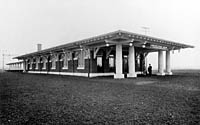
The original Dempster Street
station, looking southwest on April 13, 1925, about two
weeks after its opening. The clean, horizontal lines of the
Prairie School-influenced station are evident, but so is the
limited potential for passenger traffic judging by the open
space around the building. For a larger view, click
here.
(Photo from the Krambles-Peterson
Archive)
|
Arthur U. Gerber, staff architect for Sam Insull, designed the depot
in 1924. The station is generally considered Gerber's crowning
achievement and was nearly identical to stations built at Kenosha and
Mundelein further north on the interurban. The station was designed
as both a terminal (for the "L") and a through station (for the North
Shore Line) and featured a single high-level island platform
projecting from the rear of the station house for the former as well
as dual low-level platforms adjacent to the west to serve the
latter.
The Dempster Street station's architecture is an interesting mix
of styles. While the building is often classified as Prairie School
based on its intricate eaves and bracket work, low-pitched roof,
multi-paned casement windows and strong horizontal lines, closer
examination of the structure indicates that elements such as its
textured exterior brickwork and elaborately bracketed eaves with
exposed rafters more closely classify the building as belonging to
the bungalow vernacular style, a building type popular at the time
with residential development at the time but rarely seen in rail
stations.
The exterior is executed in dark textured brick with a foundation,
belt course (through the windows) and plain slip windowsills of light
cast stone. The station has a low-pitched hipped roof with
overhanging eaves on all four sides, especially in the front and rear
where it creates a porch supported by massive tapered cement posts.
The window along the side elevations have a typically Prairie School
design, with each bay consisting of three long, narrow, vertical
multipaned windows flanked on either side by smaller square
nine-paned windows, with each window bay divided by a pier and eave
bracket. Exposed rafters and wooden brackets under the eaves fill out
he exterior decoration and a signature Gerber touch included globe
lamps under the eaves.

The Dempster station's
original interior on April 13, 1925. Except for the
restrooms and baggage room in the rear, the interior of the
station was an open waiting room with just benches and a
lunch counter. For a larger view, click here.
(Photo from the Krambles-Peterson
Archive)
|
The interior was simple and open, but still quite attractive. It
included pink and green terrazzo floors, brick walls with cast stone
sills, wooden moldings, and coved ceilings. Most of the interior was
a waiting room, an open space with rows of heavy carved wooden
benches. Toward the back of the interior, at the south end, were a
men's restroom with a smoking lounge on the west side and a baggage
room and ladies' restroom on the east, bisected by a hallway that led
to the south doorway to the platforms. A wooden ticket agents' booth
stood at the mouth of the hallway in the back of the waiting room,
while a lunch counter was located in the southwest corner.
The official opening of the "L"'s new Niles Center branch was held
on March 28, 1925 at the Dempster station. Three special trains
carried dignitaries and officials to an elaborate ceremony at
Dempster where an estimated 2,000 onlookers were assembled. Speeches
were made and an air show was performed in the skies over the
terminal. "L" service to Dempster station and seven other
intermediate stops on the Niles Center branch began at the conclusion
of the ceremony. North Shore Line service through the station was
inaugurated on June 5, 1926.
At the time of the station's construction, Niles Center was a
largely unsettled place with what little population there was huddled
a mile or so south near the Oakton Street station, which had a
similar but far more restrained design. The Niles Center branch
typically operated single-car shuttle trains between Dempster and
Howard, which was more than adequate to
serve the population. During rush hours, the train lengths were
doubled to two cars, but remained shuttles until 1929, when a rush
hour through-service south of Howard was
instituted. In the morning, eight Niles Center trains were coupled
onto the back of southbound Jackson Park expresses for the trip
downtown and nine northbound Howard expresses in the evening carried
two cars to be split from the train at Howard
for the trip to Dempster. This level of service, although much more
convenient, was unwarranted by the sparse population along the line
and dropped in 1930. Little changed on the line for the following
decade and a half.
"L" Service is Withdrawn, North Shore Soldiers On
The construction of the interurban/rapid transit line was part of
a larger development plan for the suburb, which was subdivided and
improved with streets, sidewalks, and utilities around the same time.
Many lots sold and some homes and buildings were built, but Niles
Center's land boom was short-lived. Within just a few years of the
opening of the Skokie Valley Route and the CRT's Niles Center local
service the Depression hit. New construction virtually halted and
thousands of the 30-foot lots that had been platted and sold just a
few years earlier were worthless.
By the time the Chicago Transit Authority took over in 1947, the
Niles Center branch's prospects for high (or even respectable)
ridership levels were still dim. The hoped-for development of Niles
Center was squelched by the Depression just a few years after the
line opened, and remained unfeasible through World War II. After
assuming operation of the "L" system, the
CTA studied each rapid transit
line and monitored each station. Then, bit by bit, they closed the
stations and lines that were most uneconomical and had the lowest
ridership to concentrate on the stronger routes. The Niles Center
Line fell victim to this systematic pruning when on March 27, 1948,
service between Howard and Dempster was
replaced by the #97 Skokie bus line. This date was chosen in large
part because it so happened that the North Shore Line's employees
went on strike on this date -- one of several NSL strikes of the
1940s -- meaning that the Skokie Valley Route was not staffed,
preventing the Niles Center branch from operating. Service had to be
suspended on the branch due to the North Shore Line strike anyway, so
it was a convenient opportunity served to drop a service that was
marginal at best.
The North Shore Line continued to operate on the Skokie Valley
Route and provide service to Dempster station. Although it was not
long after the Second World War that Skokie experienced its second
major expansion boom, its low density, new wider streets, and the
construction of the Edens Expressway on the west edge of the village
meant that the postwar vision for Skokie was not centered around
transit. The North Shore Line continued to struggle financially and
after repeated petition filings, the Interstate Commerce Commission
granted the North Shore Line the right to begin abandonment process
on May 18, 1962. The Chicago North Shore and Milwaukee ceased
operation in the early morning hours of January 21, 1963.
Conversion to Retail and the "L" Swiftly Returns
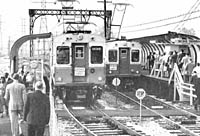
The Skokie Swift service was
popular from its opening day in 1964, when 6,500 traveled
the route daily. The 1-50
series cars seen
here at the "temporary" Dempster station were later
supplemented by 5000-series
units. For a larger view, click here.
(Photo from the Chicago Transit
Authority Collection)
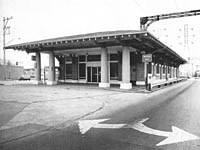
The original Dempster Street
station, looking south circa 1985, was no longer in transit
use had been converted to commercial space. Buses circled
the building, exiting onto Dempster on the driveway at right
that was formerly the North Shore Line ROW. For a larger
view, click here.
(Photo by Olga
Stefanos)
|
Within a matter of months after abandonment of the North Shore Line,
the CTA bought the station as
part of its purchase of the former interurban right-of-way as far
north as Dempster Street. The Transit Authority planned to resume "L"
service over the line, though rather than a local branch service it
was envisioned as a nonstop shuttle between Dempster and Howard.
The "Skokie Swift", as it was dubbed, was a "demonstration
project" conducted under the terms of the National Housing Act of
1961 and was to be provided on an experimental basis for a duration
of two years beginning in April 1964. The project was funded by the
Chicago Transit Authority, Village of Skokie, and the U.S. Housing
and Home Finance Agency (which became the Department of Housing and
Urban Development [HUD] during the project).
The goal of the Swift was to see if an effective, economical, and
passenger-friendly service could be established linking a typical
postwar suburb to an urban center. A park'n'ride lot for 555 cars was
constructed at the Dempster Swift terminal, along with a
kiss'n'ride area (novel for the time) where riders could be dropped
off and picked up by auto. Space was also provided for interchange
between the Skokie Swift and suburban bus companies. All of
these facilities were provided based on the idea that suburbanites
heading to the city might be drawn out of their autos if a transit
service was provided that was fast, attractive, and efficient, plus
that they could drive (or be driven) to. These features allowed the
new service to cater to the auto market, which was fast taking hold
in suburban America in the postwar era. The station's close proximity
to the Edens Expressway additionally helped this objective.
The Skokie Swift operated for a few hours on April 18, 1964
to provide demonstration rides. For the inaugural train on this
demonstration day, the four 1-50
series cars 1-4 were coupled together into a four-car train,
though only single-car trains were intended to run during regular
service. VIP passengers were carried from Dempster to Howard
(with no station stop) and returned to Dempster where speeches were
made. Officially, the Swift opened to the public on Monday, April 20,
1964. Initially only weekday service was to be offered, but because
of the line's instant popularity Saturday service was added effective
April 25, the first weekend after service began.
Given that the service was initially envisioned as a two-year
experiment, the CTA chose not
to use the existing station at Dempster as the investment for
improvements and operating costs required by re-inhabiting it were
not warranted by what was supposed to be a short-term demonstration
project. Instead, two small platforms were built to the southwest
with green plexiglas canopies and a wooden ticket agent's booth.
Still, the CTA now owned old
Dempster station building and could put it to some beneficial use.
So, in 1964, the building was converted to rented concession spaces
and served in that capacity for 30 years.
The old Dempster station building entered a period of decline
following the abandonment of North Shore Line service. Over the
years, piecemeal changes took their toll on the station's appearance.
The interior, previously a single open waiting room, was partitioned
into separate spaces. All but two of the side window bays were
in-filled with brick (of a different type and shade than the rest of
the exterior walls, no less), as they no longer matched with the
interior. The front doors and windows were altered to create a better
storefront and the rear portico was enclosed with aluminum and
Plexiglas curtain walls to create additional tenant space. The
building became the center of a turnaround for
CTA and suburban buses. Still,
despite these unfortunate changes, the building still retained the
majority of its design integrity.
In summer 1969, Greyhound Lines and CTA entered into an agreement allowing Greyhound intercity buses to use three CTA rapid stations as "satellite" terminals. Under terms of the pact, Greyhound coaches from and to Chicago would stop at the Dempster Street Skokie Swift station, the Jefferson Park station on the Kennedy rapid transit line and the 95th station on the Dan Ryan line. Greyhound service began in early August 1969 at the Dempster station, and upon the opening of the 95th and Jefferson Park terminals (September 1969 and February 1970, respectively).
A Greyhound ticket office was located at each outlying "L" station, and was initially staffed and sold a complete line of Greyhound tickets at no extra cost. The ticket office at Dempster was located in the old 1925 station house that was not used for Skokie Swift operations, and was operated by Greyhound. The Dempster station also served as a terminal for Greyhound's package express service, providing convenient shipping and receiving facilities for north and northwest suburban industries.
In operation, Greyhound buses departing from the company's Loop terminal on Randolph Street stopped at the three stations as they leave Chicago. Coaches going north would tie in at Dempster, those going generally west would stop at Jefferson Park, while coaches bound for the east and southern United States would link up with the CTA at the 95th Street station. Greyhounds arriving in Chicago would also use the stations as a stop on their way to the Loop. The idea was for Chicagoans to be able to board Greyhounds bound for outlying cities around the United States without traveling into the busy Loop area.
The number of Greyhounds using the rapid stations daily was extensive at the outset. Greyhound scheduled 24 arrivals and departures daily at 95th, including Scenicruisers to and from Detroit, Pittsburgh, Memphis, St. Louis, New York City, and numerous other key cities. Jefferson Park was serviced by 10 arrivals and departures daily while Dempster accommodated 11 arrivals and departures. The number of intercity buses serving the outlying "L" terminals declined over time, however.
A New Station Threatens the Old
After the Skokie Swift ended as a demonstration project in 1966,
the line became a regular CTA rapid transit line. The "temporary" Dempster Swift station
built for the demonstration project in 1964, however, served for
about thirty years. In the early 1990s, it was finally replaced with
a new, more substantial, permanent brick station house. Designed by
the architectural firm of Dubin, Dubin and Moutoussamy at a cost of
$3.4 million, the new rapid transit station house is roughly in the
same location as the temporary inbound platform, and the new
platforms were immediately to the south of the old ones.

A new, permanent terminal
was built at Dempster in 1994. Looking south on December 30,
2003 as an inbound train boards passengers, the station
consists of a station house and boarding platform on the
west and a simple alighting platform on the east. Note that
the tracks are converging as they approach the camera:
trains switch directions and change ends on a single tail
track north of the platforms. For a larger view, click
here.
(Photo by Graham
Garfield)
|
The new station house is a simple, rectilinear brick building with a
cast concrete watertable and cast stone sills and large projecting
cornice over the front entrance. The interior is equally simple, with
brick walls and concrete sills. The floors are concrete and lighting
is recessed in the ceiling. A small concession space is provided to
the west of the front entrance. A stainless steel agent's booth, fare
controls, TransitCard vending machines and a payment station for the
park'n'ride finish out the interior. The side platforms are short,
only able to berth about a two-car train. They have simple canopies
of green steel supports with posts that flare at the bottoms and
white metal roofing, partitions, and railings. The inbound platform
projects from the back of the station house. The outbound platform
has no fare controls and is accessible to anyone, though it's filled
with signs warning "DO NOT BOARD".
Construction began in 1993, with the completed terminal coming into
use at the end of May 1994. The facility opened as "Dempster"
station, but the name was changed to "Skokie" station in 1995 as part
of a systemwide effort of changing the names of several suburban
stations from streets to the municipalities in which they're located.
The station name signs were changed to read "Skokie" and adhere to
the Green Line Graphic
Standard, but the old KDR
symbol signs that say "Dempster" were left in place until being updated in 2009.
The master plan for the new Swift terminal included not
just the rapid transit station, but also improvements to the site as
a whole. Over the years, the
CTA and suburban bus agencies
grew to feel that the turnaround encircling the old Dempster station
was inadequate for both safety and operational reasons. Funding was
obtained under Operation
Green Light, a Midwestern effort to improve traffic flow and
reduce vehicle emissions, to enlarge the park'n'ride and create new
off-street taxi stand and bus terminal facilities at Dempster... on
the site of the old CRT/North Shore station. The Village of Skokie,
who administered the Operation Green Light -funded portion of the $1
million project on behalf of the village, the state and the various
transit companies that use the terminal, planned to demolish the
Gerber station as part of the project. Confident in the details and
timetable for the terminal master plan, the
CTA terminated all of the old
station's tenants' leases effective September 30, 1992 in
anticipation of its demolition (except for Greyhound, who was to
continue to occupy the building until they could move into a new
building for their exclusive use elsewhere on-site).
With the interurban station's demolition imminent, the threat
galvanized a group of railfans, architects, historians, and
preservationists to mount a campaign to lobby for the building's
landmarking and preservation. In 1995, a nomination for the building
to the National Register of Historic Places was prepared. Placement
on the register would provide a great deal of protection for the
station, as any government-funded project that threatens a listed or
eligible structure with alteration or demolition must come under a
review to determine what the effects are and how they can be
mitigated. However, the nomination was rejected on August 29, 1995,
citing heavy alterations to the building that striped it of
sufficient historical integrity. Now more vulnerable than ever, the
building's fate seemed sealed. But a devoted group, which included
the Landmarks Preservation Council of Illinois (LPCI) and the Skokie
Historical Society, continued the fight and appealed the National
Park Service's decision. The Illinois Historic Preservation Agency
(IHPA), the state historic preservation office, resubmitted the
application and on February 28, 1996 the National Park Service
reconsidered: the station was granted listed status and was now
protected.
The building still needed a buyer, however, who would agree to
move the station out of the way of the terminal improvements and
restore it. Four years later, the station still awaited a savior and
the situation became dire. Things seemed especially perilous when, in
July 2000, Skokie's Village Board voted to tear the historic station
down. The building was for sale for $1, but whoever bought it was
required to move it and renovate it according to historic
preservation guidelines. If no one came forward, the village would
document the building, then they would demolish it.
A New Life for an Old Station
With a date with the wrecking ball looming on the horizon, a
development team stepped forward less than a year later with a plan
for rehabilitating the building that met the requirements of IHPA and
the village. A partnership of the Taxman Corporation, led by
president Seymour Taxman, and Scott Gendell's Terraco Inc. paid $1 to
buy the building from the CTA ,
but pledged close to $1 million to move the building, refurbish it
according to the Secretary of the Interior's Guidelines for Historic
Structures, and reopen it as a retail outlet. Plans for the
restoration of the building included cleaning the brickwork and
replacing missing masonry, restoring the Prairie-style windows (which
it turned out were still underneath the brick veneer the filled in
the windows) and installing duplicates where necessary, replacing the
asphalt-shingled roof with the original green clay tile, and adding
copper gutters and other historically-accurate finishes.
The 4,000-square-foot building was to be moved 130 feet east to
make room for the parking and transit improvements that had been
programmed for the site under Operation Green Light. The developers
brought in noted Chicago architecture and planning firm Antunovich
Associates, who has worked on a number of high-profile historic
restorations, including the former Reliance Building in downtown
Chicago, to lead the restoration project.
The prospects for the building's restoration took an ominous turn,
briefly, in Fall 2002 when two fires occurred in the station in a
48-hour period. First, a small fire broke out on September 10, 2002,
which was blamed on a short in the building's 78-year-old wiring.
Firefighters had the fire, which was on the roof of the commercial
space last occupied by Greyhound Lines, who had relocated into a
concession space in the CTA Yellow Line station about three weeks before, quickly extinguished.
But Skokie firefighters returned to the building on September 12 to
extinguish another blaze. This time the fire was more substantial,
causing damage to the roof at the south end of the building. Skokie
Fire Department Captain Barry Liss said at the time that the damage
was "easily repairable" during restoration, and that the damage
beneath the roof was minimal. None of the exterior historic fabric
was damaged in either fire. With that, Taxman and Terraco went
forward with their plans.
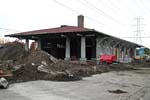
The rear porch of the
Dempster
station -- with its columns matching the front -- from which
the CRT island platform once projected, has been uncovered
for the first time in decades, as seen in this view looking
northwest on October 26, 2002. For a larger view, click
here.
(Photo by Graham Garfield)
|
Work on the historic station began in late August 2002. By
mid-September 2002, removal of all of the non-historic partitions and
additions was nearly complete. Preparations for relocation of the
Dempster station began in mid-October. As a result of the
construction activities beginning for the massive building's
relocation, the CTA vacated the bus turnaround that encircled the
structure. Effective at 2000 hours, October 15, 2002, the Dempster
Street entrance to the park'n'ride lot closed and buses no longer
entered the station area to drop off and pick up passengers. By the
end of October, excavators had dug a trench around the former
station, about 12-15 feet deep and about five feet wide in
preparation for the building to be lifted from underneath and moved.
A new two-way steel frame was welded underneath the building for the
move. While excavating the driveway along the west elevation, last
used as part of the bus turnaround around the station, some tie
remnants from the former North Shore Line northbound track were still
in place below the asphalt.
A new foundation in the station's new location had been laid at
the new building location by December 2002. After several months of
preparation, the building was moved into place over its new
foundation on January 15, 2003. The concrete columns were moved
separately to their locations on the new foundation, so during the
move the porch eaves were dramatically cantilevered, supported by
angled steel tube columns attached to the steel frame under the
building. The station was lowered onto its new foundation in early
February.
Restoration work accelerated once the station was in its new
location. When all of the bricked-over windows were opened up, it was
revealed that most of the original windows and frames were, in fact,
still intact behind the face bricks. Once the building was moved,
crews set about restoring the structure, rehabilitating those
elements still in place and in good condition, and replicating those
that were missing or deteriorated. A new roof of matte green,
speckled clay Spanish-style tile made by the same firm that
manufactured the originals was applied and largely complete by the
end of August 2003. The brickwork was cleaned and those windows that
needed replacement were duplicated according to the original designs.
The exterior woodwork, including window frames, eaves, and rafters,
were repaired and painted. New lights that replicate the original
globes on the edge of the roof eaves were installed.

The historic Dempster
station stands in its new location on August 13, 2003 with
its exterior restoration largely complete, with the
afternoon sun glimmering on the copper flashing. Note the
notch in the sill of one of the side windows for the
drive-thru. For a larger image, click here.
(Photo by Graham
Garfield)
|
The interior was not restored to the original design, instead
electing to provide an open, unfinished interior, a common practice
in the retail industry where a tenant is given a "shell" to build out
to their needs and specifications. Early in the process, Starbucks,
the trendy Seattle-based national coffee chain, expressed interest in
leasing part of the building. Other occupants for the building that
were discussed have included a bank branch and a small museum space,
but these did not come to fruition. The developers and architects
worked closely with historians and architectural preservationists to
make sure that the interior design and build-out of the lessees is
appropriate to the building, in addition to meeting the needs of the
tenant businesses. For instance, Starbucks requested to have a
drive-thru window in the building, a feature of many new Starbucks,
especially those in suburban areas. Starbuck's need was accommodated
by installing a new window on the east elevation that copies Gerber's
Prairie School design, with the exception of a small opening to pass
food and beverage orders through. Overall, the modification is barely
discernible.
Restoration work, as well as construction of the parking and
transit improvements on the former site of the building, continued
through the spring and summer. By Fall 2003, Dempster station was
ready for occupancy. Starbucks built out their retail space during
October and November and was ready for business by the week before
Thanksgiving.
The official dedication of both the Dempster station renovation
and the improvements to what the Village of Skokie dubs the "Skokie
Swift Transportation Center" was held on Monday, November 24, 2003 at
10am. Inside the Starbucks, housed in the front half of the restored
station, a capacity crowd of journalists and invited guests listened
to supportive and impassioned speeches by officials and individuals
to worked on or supported the project, perhaps in some ways mirroring
the ceremony marking the opening of the station 78 1/2 years before.
Among those attending included developers Sy Taxman and Scott
Gendell; Joseph Antunovich, chairman of LPCI and head of Antunovich
Associates; Skokie Mayor George Van Dusen; CTA President Frank
Kruesi; and Pace Executive Director Thomas Ross. After the speeches,
the ceremony moved out to the entrance to the new intermodal terminal
beside the station, where officials cut a ceremonial ribbon stretched
across the driveway. After cutting the ribbon, the guests moved back
into the station to mingle and enjoy refreshments supplied by
Starbucks.
The new parking lots and taxi stand came into use shortly before
the station dedication, in mid-November. The
CTA waited to divert its buses
off Dempster Street and into the new bus terminal until the
installation of the globed lights under the bus canopy is complete,
making it suitable for both day and night use. The lights were
installed in late December 2003 and the
CTA and Pace began using the
new Dempster bus turnaround at 0400 hours, Monday, January 19, 2004.
It serves the CTA's #97 Skokie
and #54B North Cicero/Skokie Boulevard routes, as well as Pace's #250
and #626 routes and Greyhound intercity buses.
Greyhound Lines Inc., which had been struggling financially since
the 2001 terrorist attacks, announced plans on Friday, June 25, 2004
to discontinue service to Skokie as part of the elimination of 14
million miles from its system, representing 10 percent of the
carrier's total locations across the United States. Greyhound will
make the cut sometime before 2007.
During Summer 2004, the restored historic station became fully
occupied with retail businesses. On July 30, 2004, Washington Mutual,
a west coast bank, moved into the rear rental space and opened its
"Skokie Swift Station Financial Center." In an interesting irony,
there is a drive through window at the building, but it's for
Starbucks not for the bank.
A New Name
On June 8, 2011, the Chicago Transit Board authorized the renaming of the Skokie station and approved names for two stations currently under construction, including the new Oakton station one mile south on the Yellow Line.
The new station being built at Oakton Street was officially named the Oakton-Skokie station. Skokie station was renamed the "Dempster-Skokie" station to differentiate it from Oakton, which is also located in the Village of Skokie and is adjacent to downtown Skokie.
Signage at the station was updated in January 2012. System maps, and pre-recorded announcements and car card maps inside the railcars will be updated to reflect the changes when the Oakton station project is completed.

The side platforms at
Dempster-Skokie terminal are seen looking north at the inbound platform on
February 7, 2012. The
station house for inbound riders is in the background. The platforms are
short, only capable of berthing a two-car train. For a
larger view, click here.
(Photo by Graham
Garfield)
|
 Dempster (CRT/NSL)
station | "Temporary"
Skokie Swift station |
Yellow Line
station
Dempster (CRT/NSL)
station | "Temporary"
Skokie Swift station |
Yellow Line
station

|
dempster03.jpg
(122k)
Although few people lived along the Niles Center
line, a large crowd was on hand for the dedication
ceremonies at Dempster Street on March 28, 1925. Car 1808
led the long train of otherwise steel 4000-series
cars, which in fact rarely operated on the branch.
(Photo from the Bruce G. Moffat
Collection)
|

|
dempster06.jpg
(116k)
The historic Dempster station, looking south on
September 13, 2002. In later years, a drop ceiling was
installed under the front porch eaves, which unfortunately
turned out to be a sanctuary for pigeons. The building is
blocked off by yellow Skokie Fire Department tape following
two small fires, one on September 10 and another on
September 12, 2002. (Photo by Graham
Garfield)
|
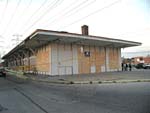
|
dempster07.jpg
(114k)
A plexiglas partition was built around the original
rear of the historic station building -- when the "L" used
the station in 1925-48, an island platform projected out
from here -- after it was concerted to commercial space. The
rear sections last tenant was a dry cleaners. Following a
fire on September 10, 2002, the rear partition;s windows and
doors were covered with plywood, as seen on September 13,
2002. (Photo by Graham Garfield)
|

|
dempster08.jpg
(156k)
Several of the original, Prairie-style windows are
still extant in the station house, as seen here looking
south along the west elevation on September 13, 2002,
although most have been bricked over, like those on the
extreme left. The North Shore Line, which used this as a
through-station, would have had its outbound platform where
the driveway is now. (Photo by Graham
Garfield)
|

|
dempster09.jpg
(155k)
The best examples of original windows in the historic
Dempster station can be found at the south end of the east
elevation, seen here on September 13, 2002. The tall, thin,
vertical windows alternated with the horizontal band of
square windows, both with thin wooden mullions, gives the
windows (and the building as a whole) a particularly Prairie
School feel. (Photo by Graham
Garfield)
|

|
dempster10.jpg
(146k)
After the old 1920s station was converted to
commercial space, an entrance was added to the east side for
the retail space in the middle of the building. Last
occupied by Greyhound
bus lines, the space was vacated on early September 2002
when Greyhound moved into the current
CTA Yellow Line
station's concession space. A small electrical fire over the
former bus station entrance on September 10th caused minor
damage to the station roof and eaves, as seen on September
13, 2002. (Photo by Graham
Garfield)
|

|
dempster11.jpg
(119k)
By October 26, 2002, the front elevation has not yet
seen significant work, with most attention thus far given to
the sides and rear. (Photo by Graham
Garfield)
|
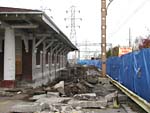
|
dempster12.jpg
(154k)
The driveway along the west elevation, seen here on
October 26, 2002, was originally the right-of-way of the
northbound North Shore Line track. Some old ties were found
below the asphalt and excavated. Although this strip seems
exceptionally narrow, the North Shore Line actually ran
their track along the right side, while a narrow side
platform was squeezed between the track and the station
house. (Photo by Graham Garfield)
|

|
dempster14.jpg
(131k)
The historic Dempster station has been relocated to
its new home on the east edge of the property, looking
southeast on March 7, 2003. (Photo by Graham
Garfield)
|

|
dempster15.jpg
(147k)
The former site of the North Shore Line Dempster
station is now empty, as seen in this view looking south on
March 7, 2003. The North Shore Line's catenary towers are
still delineating the former right-of-way of the interurban,
which the station served, on the right. The current Yellow
Line terminal is visible in the background.
(Photo by Graham Garfield)
|
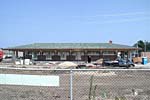
|
dempster17.jpg
(172k)
As part of the extensive exterior restoration, the
Dempster station's Prairie School windows and green slate
roof were restored, as seen in this side view of the west
elevation, looking east on August 13, 2003.
(Photo by Graham Garfield)
|
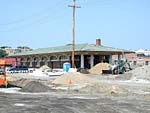
|
dempster18.jpg
(176k)
This view of the station's rear looking northeast on
August 13, 2003 shows that some work is still underway,
including completion of the new roof. The interior is not
being restored so that the retail occupant can build to
their needs. (Photo by Graham
Garfield)
|

|
dempster19.jpg
(182k)
By Fall, the station's restoration was largely
compete. Seen looking southeast on November 9, 2003, the
station's exterior renovation work is mostly complete,
including the installation of the trademark Gerber globe
lights and the replica of the station entrance sign on the
front eave. Only small touches like landscaping and other
minor finishes remain. (Photo by Graham
Garfield)
|

|
dempster20.jpg
(140k)
The overall layout of the new intermodal improvement
is seen in this November 9, 2003 view looking north: a new
bus terminal at left, a main driveway in the center, and
relocated Dempster station on the right. Additional parking
is out of frame to the right. The
CTA station is behind
the photographer. (Photo by Graham
Garfield)
|

|
dempster21.jpg
(147k)
The Craftsman-influenced brackets of the new bus
terminal canopy, a replica of the canopy that was over the
island platform that Gerber designed to serve the "L" in the
original station design, is seen looking north on November
9, 2003. Although the canopy is structurally complete by
this point, the lights are still yet to be installed.
(Photo by Graham Garfield)
|
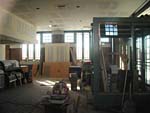
|
dempster22.jpg
(119k)
Starbucks began to build out their store in the north
half of the restored Dempster station in October 2003. By
this November 9, 2003 view looking west, the counter and
overhead soffit, vestibule at the entrance, and many other
features were in place or under construction. During the
following couple weeks, the remaining finishes were applied.
(Photo by Graham Garfield)
|

|
dempster23.jpg
(119k)
The south half of the historic Dempster station is
still yet to be leased as of early 2004. Seen looking north
on November 9, 2003, it is merely a shell, an open space
that whatever lessee moves in can build out to their own
needs and specifications. (Photo by Graham
Garfield)
|
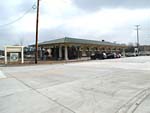
|
dempster24.jpg
(113k)
The restored and relocated Dempster station is seen
looking southeast on November 24, 2003. The freestanding
Starbucks sign in front is a near-replica of one that North
Shore Line had in front of the station.
(Photo by Graham Garfield)
|

|
dempster25.jpg
(164k)
The front porch of the station, seen looking south on
November 24, 2003, is used as an outdoor seating area by
Starbucks. The sign hanging from the eaves is a reproduction
of one that originally adorned the station.
(Photo by Graham Garfield)
|

|
dempster26.jpg
(116k)
Behind the station is the entrance to Starbucks's
drive-thru, whose overhead sign frame design is reminiscent
of a North Shore Line sign that was in front of the station.
Looking northeast on November 24, 2003, there is some
customer parking provided along the west side of the
station. (Photo by Graham
Garfield)
|
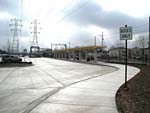
|
dempster27.jpg
(144k)
The new off-street bus terminal, seen looking south
on November 24, 2003, has enough room for a couple of buses
to berth at the curb and for buses to maneuver around one
another. A canopy has been provided to shelter waiting
passengers whose design replicates the one that was formerly
on the "L" platform on the rear of the Gerber-designed
station. (Photo by Graham
Garfield)
|

|
dempster28.jpg
(162k)
Although much of the interior is a standard Starbucks
decor, the coffee chain worked with the developer and
architects to make their build-out as sympathetic to the
station design as possible. The service counter is seen here
on November 24, 2003. (Photo by Graham
Garfield)
|

|
dempster29.jpg
(128k)
The official dedication of the restored station and
new intermodal terminal was held on November 24, 2003 at
10am. At the entrance to the new intermodal terminal beside
the historic station, officials and VIPs join Skokie Mayor
George Van Dusen as he cuts a ceremonial ribbon stretched
across the driveway. (Photo by Graham
Garfield)
|

|
dempster31.jpg
(97k)
By the time of this view looking northwest on
December 30, 2003, the "L"-platform canopy replica in the
new bus terminal was complete, with the globed lights lining
the rafters and benches and garbage cans underneath.
Although Greyhound had begun using the terminal for its
intercity service by this point, neither the
CTA nor Pace had yet
begun using the terminal yet. When
CTA moves in, they
plan to install a an information pylon with maps and
schedules. (Photo by Graham
Garfield)
|
"Temporary" Dempster
Skokie Swift station

|
skokie06.jpg
(93k)
One of the novel aspects of the Skokie Swift
operation was the way it catered to the auto with the
provision of a large park'n'ride lot to entice auto-oriented
suburbanites to the system. This view looks southwest in the
parking lot, with the temporary Dempster station and a Swift
train in the background, in 1964.
(Photo from the Chicago Transit
Authority Collection)
|
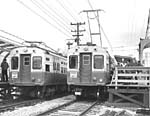
|
cta1-50s@Skokie02.jpg
(114k)
Just before the official inauguration of Skokie Swift
service on April 18, 1964, customers were treated to free
rides on the new express operation from Howard
to Dempster/Skokie. The
double-ended, 1-50
series cars from the St. Louis Car Company that were to
be used for the service were on hand to provide the
demonstration rides seen here.
(Photo from the Chicago Transit
Authority Collection)
|
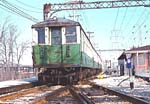
|
cta4000s10.jpg
(144k)
As the 4000s were
nearing the end of their service lives, many railfans wanted
to enjoy the cars while they were still active on the
property. A train of 4000s
are seen on the turnback track at Dempster at the end of the
Skokie Swift
on March 20, 1973 on one of many fantrips that were run in
the cars' final months, this one sponsored by CERA.
(Photo by J. Terrell Colson)
|

|
cta26c.jpg
(112k)
A train painted for the country's bicentennial celebration
stops at the inbound Dempster
(Skokie) platform on August 14, 1978. The "temporary"
platform that ended up being used for about thirty years was
eventually replaced with an all-new station in the early
1990s. (Photo by Douglas Grotjahn,
Collection of Joe Testagrose)
|

|
cta26d.jpg
(71k)
1-50 series car 26
unloads commuters at the "temporary" Dempster
station in 1978. Note that by this point the platform has
been lengthened, but the cars aren't berthing and
discharging passengers under the canopy.
(Photo by Dave Mewhinney)
|
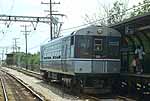
|
cta30c.jpg
(60k)
Car 30, still fresh from its rehab just a couple years
earlier, is loading passengers at Dempster Terminal at the
end of the Skokie Swift in July 1988. Car 30 remained in
service after many of the other 5-50s
were retired circa 1993 and made one of the last 5-50
revenue trips on the Yellow Line (Skokie Swift) in early
1998. (Photo by James Raymond)
|

|
cta24g.jpg
(145k)
Passengers are unloaded at the northbound platform of the
"temporary" Dempster/Skokie station from car 24 on July 31,
1974. In reality, the "temporary" Dempster station - built
in 1964 - remained in service for 30 years. Car 24 is
sporting its unique silver and charcoal paint scheme and
Skokie Swift logos.
(Photo by Doug Grotjahn, Collection
of Joe Testagrose)
|
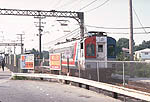
|
cta25c.jpg
(148k)
The "'Light House' Harry Lee" - car 25 in its Bicentennial
scheme - prepares to turn around for the trip back south on
the Skokie Swift on August 14, 1978. Because Dempster/Skokie
has two side platforms (one for unloading, one for loading),
to turn around trains pull north of the station onto a
single stub track, then change ends and head back south to
the "loading" platform. Car 25 has not yet changed ends...
(Photo by Doug Grotjahn, Collection of Joe
Testagrose)
|
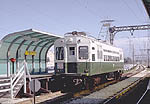
|
cta29b.jpg
(129k)
Car 29 completes its Skokie Swift run by depositing its
riders on the east platform at Dempster (Skokie) on July 22,
1968. The line being only four years old, the yellow station
sign was unique to the Dempster station.
(Photo by Doug Grotjahn, Collection of Joe
Testagrose)
|

|
cta53.jpg
(149k)
Dressed up as "The Minutemen", car 53 loads passengers at
the southbound Dempster-Skokie platform on August 14, 1978.
(Collection of Joe Testagrose)
|
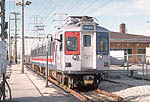
|
cta54b.jpg
(153k)
Car 54 completes its turnaround on the Dempster stub track
to head back southeast to Howard
on September 23, 1976. The original NSL/CRT Dempster
station, albeit with an unfortunate later plexiglas addition
on the back, is on the right. (Photo by Doug
Grotjahn, Collection of Joe Testagrose)
|

|
cta53k.jpg
(135k)
Car 53 stops at the Skokie Swift Terminal on July 7,
1975. (Photo by Doug Grotjahn, Collection of
Joe Testagrose)
|
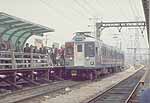
|
cta53f.jpg
(130k)
Car 53 - The Minuteman - finishes its Skokie Swift run
arriving at Dempster on May 29, 1975. (Photo
by Ed McKernen, Collection of Joe Testagrose)
|

|
cta53g.jpg
(124k)
In its mercury green, croydon cream, and swamp holly orange
paint scheme, car 53 arrives at Dempster on July 22,
1968. (Photo by Doug
Grotjahn, Collection of Joe Testagrose)
|

|
cta53j.jpg
(138k)
Bicentennially painted car 53 loads passengers at
Dempster/Skokie on July 7, 1975. (Photo by
Doug Grotjahn, Collection of Joe Testagrose)
|

|
cta4271b.jpg
(134k)
Cars 4271-4272 have just recently undergone an overhaul, as
evidenced by its gleaming exterior finish. They would be the
last 4000-series
cars to be overhauled, contributing to their being chosen to
become the CTA's preserved Historic Cars. Although it bears an
Evanston/Wilmette sign, it's actually at Dempster on the
Skokie Swift on April 22, 1973.
(Photo by Joe Testagrose)
|

|
cta4271g.jpg
(118k)
Car 4271 leads the
CTA's Historic Train
on a fan trip at Dempster Terminal on July 6, 1975.
(Photo by Doug Grotjahn, Collection of Joe
Testagrose)
|
Dempster-Skokie Yellow Line
station

|
skokie02.jpg
(67k)
A motorman takes a quick brake between runs at the
Skokie (Dempster) station as his 3200-series
train loads passengers in August 1997.
(Photo by Jon Bell)
|
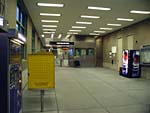
|
skokie04.jpg
(116k)
The interior of the current Yellow Line station
house, looking south on September 13, 2002. The interior is
spacious, although most of it is not used for anything in
particular. The agent's booth (now for a Customer Assistant)
is in the center, while AVMs and park'n'ride payment boxes
are on the left in the unpaid area and a concession area
(off camera) is on the right. The concession was vacant from
the opening of the station until 2002, when the Greyhound
bus station moved in from their former space in the adjacent
historic station building. By 2012, Greyhound had moved out and ceased making stops at Dempster station. (Photo by Graham
Garfield)
|

|
turnback.jpg
(128k)
Trains change direction at Skokie
terminal by pulling forward from the station into the
turnback track, adjacent to the west of the old North Shore
Line Dempster station.
The single track turnback stub is essentially the southbound
track, connecting to the northbound track by way of a
spring-and-return switch. The train when changed and ends
and proceeds to the inbound platform for the trip to
Howard. This view looks north on
September 3, 2000. (Photo by Mike
Farrell)
|
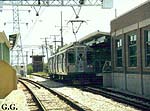
|
cta3451.jpg
(84k)
Car 3451, half of unit 3451-3452, prepares to head back
south toward Howard in this photo
looking southwest at the Dempster (Skokie) station on July
8, 1998. Note the raised pantograph. (Photo
by Graham Garfield)
|
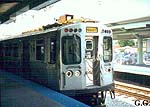
|
cta3452.jpg
(77k)
Car 3452 leads this Skokie Swift train, loading passengers
at he Dempster (Skokie) terminal on July 8, 1998. The
destination sign reads "Howard". Cars 3441-3456, identical
in all other ways to cars 3201-3440, were delivered with
pantographs, two per two-car unit, for the "Skokie Swift"
Yellow Line; the front pantograph is visible on the roof,
lowered, attached to the yellow roof board.
(Photo by Graham Garfield)
|

|
cta3200s@skokie.jpg
(54k)
A 3200-series
Skokie Swift train, stopped at the Skokie terminal in
January 1999, is seen soon after the Blizzard of '99 in this
dramatic nighttime photo. (Photo by Sean
Gash)
|

|
cta3446.jpg
(75k)
Having completed its station stop at Skokie
terminal, car 3446 trails a Yellow Line train pulling
through the station to the turnback to prepare to load
passengers on the inbound platform and head back to
Howard in July 1999.
(Photo by Mike Farrell)
|

|
cta3443c.jpg
(101k)
Car 3443 leads a two-car Yellow Line train dropping off
passengers at the alighting platform at Skokie Terminal on
July 2, 2003. This platform has no fare controls to speak
of, since the line ends here and anyone boarding would be
spotted by the operator when he switches ends.
(Photo by Leon Kay)
|
 |
skokie01.jpg (136k)
The 1994-built Skokie station house, behind and to the west of the original facility, is seen looking southwest on December 30, 2003, with its original backlit entrance graphic. (Photo by Graham
Garfield) |
 |
skokie05.jpg (184k)
The dual side platforms at Skokie terminal, looking north on the outbound platform on November 9, 2003. Although this platform is for alighting passengers only and is replete with signs instructing riders "DO NOT BOARD", it is freely accessible to the public. The station house for inbound riders is in the background, connected to the platform on the left. The platforms are short, only capable of berthing a two-car train. (Photo by Graham
Garfield) |

|
cta2319_2224.jpg
(204k)
On a fantrip on May 1, 2005, 2200-series
cars 2224 and 2319 are at Skokie
terminal. Although it was not the first ever instance of the
third rail-only cars to the former catenary territory, it
was the first fantrip. Operated as a 4-car train for most of
the trip, the cars were split at Skokie. The destination
signs on 2319 and 2223, which were on the ends of the
consist, had older destination signs installed for the trip.
(Photo by J. Terrell Colson)
|
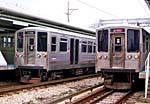
|
cta2320_2223.jpg
(176k)
In a shot that would have been nearly impossible to take
eight months before, a fantrip of 2200-series
cars sits at Dempster/Skokie
terminal on May 1, 2005. Car 2223 sports a 1980s-era roller
curtain, brought and installed specially for the fantrip.
(Photo by J. Terrell Colson)
|
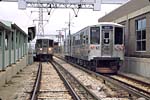
|
cta2319.jpg
(158k)
A 4-car charter of 2200-series
cars was split to reverse the train on the Dempster turnback
track and to photograph them side-by-side on May 1, 2005.
Looking south from the pedestrian crossing at Skokie
terminal, car 2319 sports a mid-1990s-era roller curtain
showing the Evanston Express reading, brought specially by
trip organizer Mark Wolodarky for the charter.
(Photo by J. Terrell Colson)
|
 |
skokie10.jpg (214k)
The outbound platform at Dempster-Skokie is seen looking north on February 7, 2012. The platform is for alighting only; after trains discharge their passengers, they pull forward onto the turnback track, change ends, and pull into the platform on the left to board inbound customers. Signs on the platform tell customers, "Do not board". The stairs on the right provide convenient access directly to the park & ride lot next to the station, while the ramp at the far end of the platform provides accessible passage to the kiss & ride pickup lanes, bus terminal, and various paths to surrounding streets. The station name and column signs were updated in January 2012 with the station's new name. The station name signs originally did not have the colored tabs standard under the Green Line Signage Standard, having been installed in the last days of the KDR Signage System. They were added when the signs were updated to make them standard. (Photo by Graham
Garfield) |
 |
skokie11.jpg (252k)
The inbound platform at Dempster-Skokie is seen looking southwest on February 7, 2012. Unlike the outbound discharge platform, the inbound platform has benches, windbreaks, and heaters, since it is intended for boarding. There is a supervisor's booth at the far end of the platform for use when operations require special attention to the operation of the terminal, but under normal conditions no supervisor is assigned here since intervals are relatively wide and scheduled services simple enough to monitor remotely. (Photo by Graham
Garfield) |
 |
cta5238a.jpg (267k)
Yellow Line run 595 has completed one of its trips, alighting its passengers on the discharge-only platform at the Dempster-Skokie terminal on April 25, 2014. Once everyone is off the train, cars 5238-39 will pull into the turnback track and change ends, starting a new trip back top Howard (seen below). (Photo by Graham Garfield) |
 |
cta5238b.jpg (199k)
A Yellow Line train composed of 2-car unit 5238-39 loads passengers at the short platform of the Dempster-Skokie station on April 25, 2014. (Photo by Graham Garfield) |
 |
cta5177.jpg (304k)
After completing its trip north and discharging its passengers at Dempster-Skokie station, a Yellow Line train trailed by car 5177 is pulling through the switch at the entrance to the turnback track, where trains switch the the inbound track and train operators can change ends -- powering down the motorcab at one end, walk the length of the train, and power up the cab at the other end -- without blocking the mainline track or station platform, on April 25, 2014. The train is passing over the ground-level walkway that connects the station park & ride, kiss & ride and bus terminal with the station house on the west side of the tracks. The crossing is labeled as "Dempster", but the street is actually several hundred feet north, beyond the end of the turnback track. (Photo by Graham Garfield) |
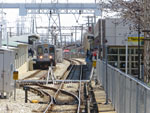 |
cta5238c.jpg (328k)
Yellow Line run 591 discharges its passengers at Dempster-Skokie station before preparing to pull forward onto the turnback track, looking south from the turnback track on April 26, 2014. On the turnback stub, the train's operator will "change ends" and operate the train from the opposite end to begin its southbound return trip. The turnback switch it not interlocked, but it is powered and run automatically by a "speed frater". (Photo by Graham Garfield) |
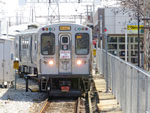 |
cta5238d.jpg (286k)
The operator of run 591 is pulling her Yellow Line train through the speed frater switch and onto the turnback track so she can reverse direction and begin the return trip to Howard on April 26, 2014. The train sports classic Skokie Swift signs on its front and rear chains in honor of the line's 50th anniversary -- in the 1960s and 70s, cars normally assigned to the line had these signs permanent mounted to the cab-end of each car, but extras that could be hung on end-door chains were kept to use on other cars that needed to "sub in" for Swift service. With the "Swift bird" used since the line began still used on the 5000-series cars' LED destination signs, the bird icon is seen on car 5238 simultaneously in both digital and analog forms. (Photo by Graham Garfield) |
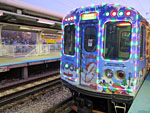 |
cta2894-HolidayTrain2014a.jpg (276k)
The contours of Holiday Train car 2894's end cap are outlined by strands of multi-colored lights, as dusk sets in on the evening of December 23, 2014, while the train visits the Yellow Line on the last night of its 2014 season service. (Photo by
Corey Ellison) |
 |
cta2894-HolidayTrain2014b.jpg (170k)
The Holiday Train makes for an impressive display at night, when its thousands of multi-colored lights illuminate its exterior and outline its contours. Actually, while operating on the Yellow Line on its last day of service, there are three Holiday Trains -- due to the capacity limitations of the Dempster-Skokie platform and turnback track, the flatcar and its sleigh are set aside and the six passenger cars are divided into three 2-car trains, which provide all Yellow Line service for several hours. Here, car 2894 leads one of the Holiday Trains discharging its passengers at Dempster on December 23, 2014. (Photo by
Bruce Moffat) |
 |
cta2894-95-HolidayTrain2014a.jpg (159k)
Two of the three 2-car Holiday Trains providing service on the Yellow Line on the evening of December 23, 2014, meet at Dempster-Skokie station, the train on the left arriving from Chicago while the train on the right loads passengers for the trip back to Howard. (Photo by
Bruce Moffat) |
 |
cta7005-06_20210804b.jpg (400k)
7000-series prototype unit 7005-7006, with the former at the rear, has discharged its passengers at Dempster-Skokie and is moving onto the turnback track north of the station to change ends and return to Howard, looking north on August 4, 2021. (Photo by Lou Gerard) |
 |
cta7005-06_20210804c.jpg (435k)
After changing ends on the turnback track, car 7005 leads a 2-car Yellow Line train crossing the pedestrian crossing and pulling into the boarding platform at Dempster-Skokie to begin its southbound trip on August 4, 2021. (Photo by Lou Gerard) |
 |
cta7005-06_20210804d.jpg (417k)
Prototype 7000-series unit 7005-7005 is berthed at the Dempster-Skokie terminal on August 4, 2021, as it awaits departure time for its southbound trip. (Photo by Lou Gerard) |
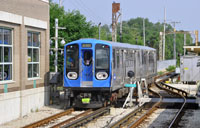 |
cta7010_20210805.jpg (412k)
Car 7010 and its mate, 7009, has just gone through the turnback track at Dempster-Skokie terminal, and is returning to the station to berth at the inbound platform to begin its trip south, crossing over the station's pedestrian crossing on August 5, 2021. (Photo by Lou Gerard) |
 |
cta7010-09_20210805c.jpg (391k)
Car 7010 leads a 2-car Yellow Line train pulling into the station pocket at Dempster-Skokie station, passing alongside the station house on August 5, 2021. (Photo by Lou Gerard) |

1 Information from
the Official
Arthur U. Gerber Homepage

















































































